| |
Veterinary
physiotherapy...
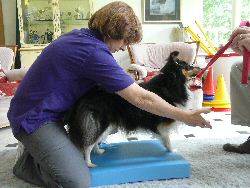 Agility dogs are the athletes of the canine world and, as such,
they are subjected to far more stresses and strains than the average pet dog.
In order to perform to their optimum
ability, they need a good diet, a general fitness programme based on
cross-training principles, sport-specific conditioning and training as well as
adequate time for rest and recuperation. ACPAT Chartered Physiotherapist Sally Medcalf,
herself an agility competitor, strongly believes that prevention is always
better than a cure... Agility dogs are the athletes of the canine world and, as such,
they are subjected to far more stresses and strains than the average pet dog.
In order to perform to their optimum
ability, they need a good diet, a general fitness programme based on
cross-training principles, sport-specific conditioning and training as well as
adequate time for rest and recuperation. ACPAT Chartered Physiotherapist Sally Medcalf,
herself an agility competitor, strongly believes that prevention is always
better than a cure...
Injury prevention and performance
enhancement training is all about minimizing the risks, but what can you do? Agility is a high
risk sport due to fast running speeds, twisting, turning, and rapid accelerating and braking.
That's why our Agility dogs need to have power in their hind legs, flexibility through their neck,
back and shoulders, and to have highly developed core stability, body awareness, concentration
and confidence.
I suggest injury prevention and
performance enhancement programs for agility dogs. These include advice on competition warm up
and cool down routines, stretching protocols, stability balance and strengthening exercises and
hind leg awareness and proprioceptive training aimed at improving muscular reaction times,
movement efficiency and mental focus.
If dogs misjudge the timing of an
obstacle, they need to call on all their physical reserves to regain control and escape injury,
which they can only do if their muscle co-ordination is highly tuned. Weaving is an unnatural
movement and requires good co-ordination, and flexibility through the spine and shoulders. If
dogs are lacking these elements, then they will be predisposed to muscle and joint strains.
Despite the best preparation, not all
injuries can be prevented, as is the case for human athletes performing at their optimum level.
As approximately 50% of a dog’s body mass is skeletal muscle, it's not surprising that a grade
1 muscle strain is the commonest injury in the working dog and one which often goes
undiagnosed. Strains occur frequently between the shoulder blades as a result of concussion
from repeated landings, twisting and turning can strain back, abdominal and intercostal
muscles, as can repetitive stress from weaving. The power muscles of the hind legs are also a
common site of injury due to uncoordinated muscle actions.
 Other common injuries include ligament
and joint strains. Carpal (wrist) joints are vulnerable on landing, especially on uneven ground
or as dogs turn as they land, and weaving puts the back and shoulder joints at risk. When dogs
are working, their intense motivation and high adrenaline levels can over-ride the pain from
minor injuries. Other common injuries include ligament
and joint strains. Carpal (wrist) joints are vulnerable on landing, especially on uneven ground
or as dogs turn as they land, and weaving puts the back and shoulder joints at risk. When dogs
are working, their intense motivation and high adrenaline levels can over-ride the pain from
minor injuries.
Working through injuries in this way
results in increased tissue damage over time. Often it is only when dogs have rested after
working that injuries can become apparent. It is important that we, as handlers and owners,
learn to recognise the signs of minor injury which may be no more than a subtle loss of
performance.
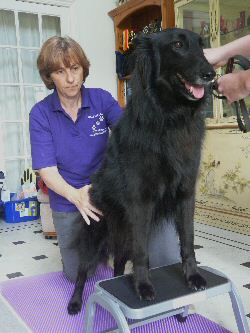 Watch
out for signs of injury Watch
out for signs of injury
-
Slight drop in performance or
reduction in average course time
-
Subtle change in enthusiasm or
behaviour
-
Change in jumping style / measuring
jumps / consistently taking down poles
-
Coming out of the weaves or missing a
pole
-
Standing with one leg placed
consistently to the outside or centrally under their body
-
One or two paws spread out more than
others
-
Moving with their hind limbs on a
different track to their fore limbs
-
Not sitting squarely / sitting back
on the haunches / one leg out to the side
-
Sensitivity to touch / hot spots /
alterations in coat
If you notice any of these signs, I
recommend that your dog should have a physiotherapy assessment as it is possibly carrying an
injury which, left untreated, can cause more serious damage over time. I also advise pre and
post-season checks to screen for minor injuries.
Before competing, it is essential that you warm up your dog
Warming up will raise your dog's heart
rate, increase the blood flow to their muscles and hence provide them with valuable oxygen to
produce the energy needed to perform. It also increases their muscles' elasticity which reduces
the risk of injury and their muscle reaction time. It tunes in their neuromuscular control to
prepare them for the activity ahead.
A warm up routine should mimic the
activity the dog is about to do, but at a less demanding level - and not so prolonged - that it
causes fatigue.
This is what I suggest:-
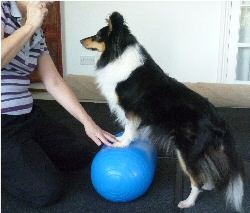 |
-
Take out of cage for five
minutes to allow sniffing, stretching and toileting.
-
Do five minutes of brisk
walking/jogging which can include activities such as heelwork, pick-ups to heel, and
balanced lead walking in circles, figures of eight and serpentine loops.
-
Then do five minutes of
controlled runs e.g. recalls, send aways, jumps over a low hurdle and controlled ball
retrieves to a rolling ball, but not running full pelt from a tight spinning circle,
screeching to a halt or jumping up and twisting in mid-air.
- Walk briskly to the ring. Hopefully you will not
have to wait more than 20mins in the queue for your run. Ideally ask someone to queue
for you and then return the favour.
-
Whilst in queue, practice
mental focus exercises and active stretches as individually prescribed by your
physiotherapist.
|
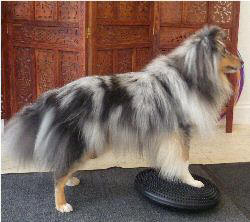 |
In extreme conditions...
-
Hot weather - Allow your
dog to stretch after being caged. A short walk may be a more appropriate warm up.
-
Cold weather - After warming
up, put a jacket onto your dog to keep its back muscles warm whilst walking to the
rings and queuing.
-
Wet and windy conditions - Put
a jacket on your dog to keep back muscles warm whilst walking to the rings and queuing,
but seriously assess the increased risk of injury to your dog from running in these
conditions.
|
Cool Down Routine
Cool down should consist firstly of making
a huge fuss of your dog for working for you. Be assured any errors on the course are usually
down to handler error. Then do five minutes brisk walking to maintain good blood circulation
and to allow for the waste products of strenuous muscle activity to be re-claimed into the
blood stream, which otherwise can cause post exercise muscle soreness. After this, offer your
dogs a drink and make sure they are comfortable - warm enough in cold weather and in the shade
in hot weather. Only then set about the course analysis of how you could have run it better!
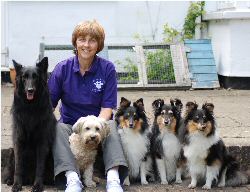 About
the author... About
the author...
Sally Medcalf is a
ACPAT Chartered
Physiotherapist and owner of VIP Vet Physio,
located Aylesbury, Bucks. She also has connection with a close colleague Susan Ward of Safe Haven Clinic
in Derby, has co-authored a series of articles relating to how physiotherapy can help with
problems arising in the various dog disciplines.
Sally is a Grade 6 handler, trains at
Trent Park DAC and is an Agility Club Approved Instructor (ACAI). She qualified and
competed at Crufts in 2008 and 2009 with Millie Mops her terrier. Sally has a special interest
in the treatment of working and competition dogs, and as a competitor and instructor she has a
deep understanding of the extra stresses and strains that dogs are subjected to in the sport of
agility.
Sally’s overall aim is to keep her
clients’ dogs free from injury, and fit for a long and happy life. She believes in the
philosophy of prevention is better than a cure, and therefore, in addition to rehabilitation
programmes for animals recovering from injury, surgery or disease, she offers injury prevention
and performance enhancement programs for puppies and canine athletes. Sally also offers mobile
agility dog clinics by special arrangement with individual training clubs and will treat
individual dogs at agility shows by prior arrangement.
For more information
contact Sally by email at Samedcalf1@aol.com or
ring m. 07842 149406. Or visit
www.vipvetphysio.co.uk
Feedback
From Katy
Parrott...
After reading the article on Agility Net about warming up and cooling down at
shows, I started thinking about training. Most of us warm up properly before a show, but how
about in classes? We have driven quite a way, we leave the dog in the car to put the
equipment up, then we get the dogs out, give them a quick pee, and a very short warm up
before we start training, but then we wait, sometimes for quite a while, in the cold in
between runs.
How long do muscles remain 'warmed
up' for? I tend to play with my dog when the dog in front of me in running (not in away to
distract the other dog, I better add!), but is this enough?
First published 9 February 2013
| |
|


 About
the author...
About
the author...